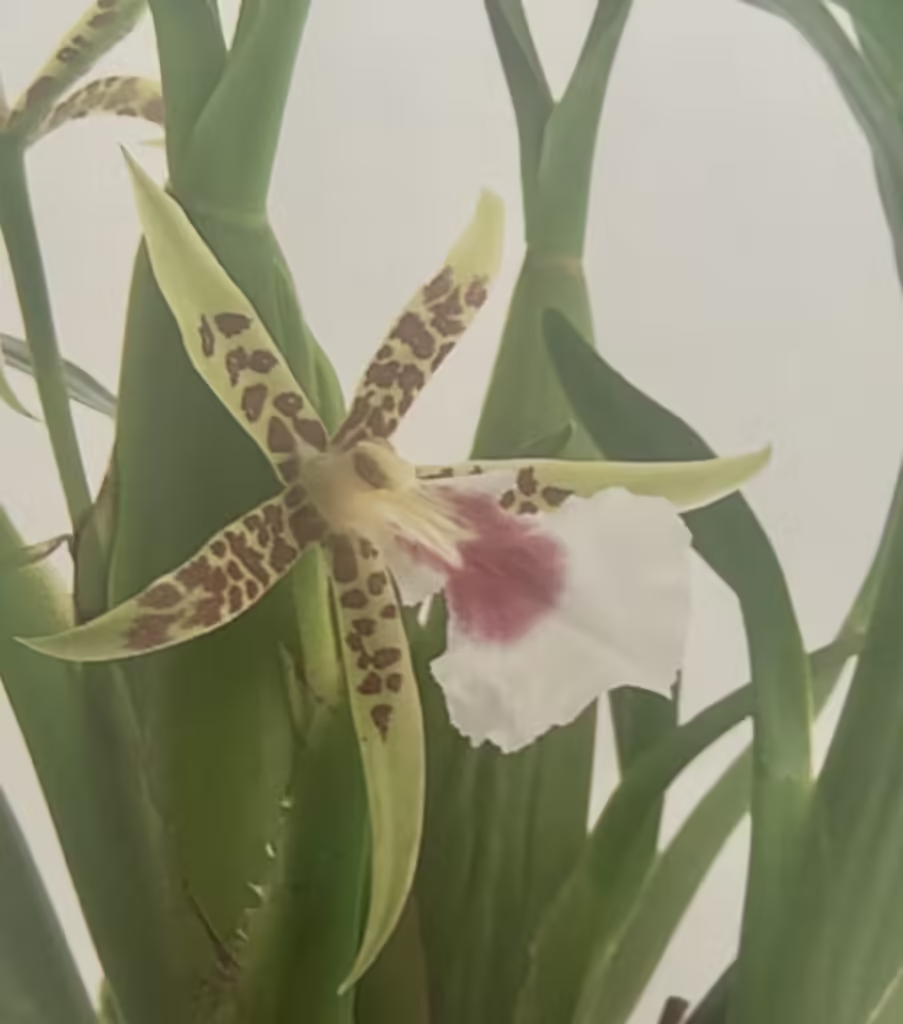
Growing and caring for the Aspasia Lunata orchid can be a rewarding experience. Native to Brazil, this unique orchid thrives in humid, tropical environments and showcases beautiful, intricately shaped flowers. As an epiphyte with a sympodial growth habit, Aspasia Lunata has specific needs in terms of planting, lighting, watering, fertilizing, and humidity. By understanding these needs, you can cultivate a healthy orchid that will bloom beautifully.
Planting Aspasia Lunata
Start with a suitable pot to accommodate the growth habit of Aspasia Lunata. Choose a pot with drainage holes to prevent water from accumulating at the bottom. Opt for a mixture of 6 parts coniferous bark, 1 part perlite, 1 part coarse sphagnum peat moss and 1 part horticultural charcoal. This combination provides excellent drainage while retaining some moisture, which is crucial for your orchid’s health.
Also since this is an epiphyte with a sympodial growth habit it can be mounted on a piece of bark.
When planting, carefully place the roots into the potting mix, ensuring they are not overly compressed. It’s essential to keep the rhizome (the horizontal stem) just above the potting mix surface. This planting method allows for healthy growth while preventing rot. Once planted, avoid moving the pot frequently. Orchids prefer stability, so choose a location that provides the right environment.
Light Requirements
Aspasia Lunata orchids thrive in bright, indirect light. In their native habitat, they grow under the canopy of trees, receiving filtered sunlight. If you are growing your orchid indoors, place it near an east or west-facing window. Avoid direct sunlight, as it can scorch the leaves. Instead, use sheer curtains to filter light if necessary.
If you rely on grow lights, choose full-spectrum bulbs that provide a balanced spectrum of light. Position the lights about 12 to 18 inches above the plant and keep them on for 12 to 14 hours daily. This routine mimics the natural day length and helps promote healthy growth.
Watering Techniques
Watering is one of the most critical aspects of caring for your Aspasia Lunata orchid. Since they are epiphytes, these orchids prefer to dry out slightly between waterings. Water the orchid thoroughly when the top inch of the potting mix feels dry to the touch. Typically, this means watering once a week, but adjust based on your home’s humidity and temperature.
During the growing season, which occurs from spring to summer, your orchid may need more frequent watering. Conversely, during the dormant season in fall and winter, you can reduce watering frequency. Always use room temperature water to avoid shocking the roots, and ensure that excess water drains out of the pot to prevent root rot.
Fertilizing Aspasia Lunata
Fertilizing your Aspasia Lunata orchid properly can encourage healthy growth and vibrant blooms. During the growing season, feed your orchid with a balanced, water-soluble fertilizer, such as a 30-10-10 formula. Dilute the fertilizer to half the recommended strength and apply it every two to four weeks. This schedule will supply essential nutrients without over-fertilizing.
In fall and winter, your orchid enters a resting phase. During this time, reduce or completely stop fertilization. Excess nutrients during dormancy can lead to weak growth and poor blooming later on.
Humidity and Temperature Needs
Aspasia Lunata orchids thrive in humid environments, ideally between 50% and 70% humidity. If you live in a dry climate, you can increase humidity by placing a humidity tray filled with water and pebbles beneath the pot. Alternatively, consider using a humidifier to maintain adequate moisture levels. Grouping plants together can also help create a more humid microenvironment.
In terms of temperature, Aspasia Lunata orchids prefer warm conditions. Aim to keep daytime temperatures between 70°F and 85°F (21°C to 29°C) and nighttime temperatures around 60°F to 70°F (15°C to 21°C). A slight temperature drop at night can encourage blooming, so monitor your environment accordingly. I like this mini hygrometer I found on Amazon to monitor the humidity levels.
Encouraging Blooms
To promote blooming, ensure your Aspasia Lunata orchid receives the right combination of light, temperature, and humidity. As the orchid matures, it will naturally produce flower spikes from the base of the plant. Patience is vital, as it may take a couple of years for a young plant to bloom.
When the flower spikes emerge, avoid moving the plant too much, as this can cause stress. Instead, maintain consistent care to allow the blooms to develop fully. When the flowers bloom, you will be rewarded with stunning, unique blooms that can last for several weeks.
Post Bloom Care
After your Aspasia Lunata orchid finishes blooming, it’s essential to provide the right care to ensure future growth. Begin by trimming the spent flower spikes close to the base of the plant. This practice helps the plant conserve energy for new growth.
Continue your regular watering and fertilization routine as the plant resumes growth. Monitor the leaves for any signs of stress or disease, and adjust your care as needed. If you notice yellowing leaves, it may indicate overwatering or insufficient light. Conversely, if the leaves are dark green and leggy, your orchid may require more light.
Happy Orchid Gardening!
In conclusion, growing and caring for Aspasia Lunata orchids involves understanding their unique needs regarding light, water, fertilization, and humidity. By providing a stable environment and following these care guidelines, you will enjoy the beauty of these stunning orchids. With patience and proper care, you can cultivate a thriving Aspasia Lunata that rewards you with breathtaking blooms year after year.
Please be sure to check out my Gardening Blog Post Page for more tips on all types of gardening. Including Seed Starting, Orchids, Water Gardening, Coldframe Gardening, Indoor Bulb Gardening, Hydroponics, Container Gardening, Mums, Herbs, African Violets, planting Bulbs, Flower Gardening, Vegetable and Fruit Gardening, Indoor Houseplants of all kinds, Cactus, Succulents, Hanging plants, Deer resistant plants and even Bird, Bee, Butterfly and Hummingbird Gardens!
